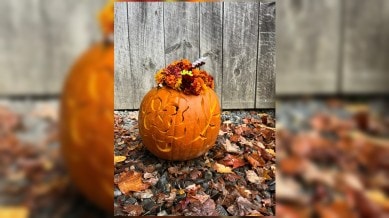📣 For more lifestyle news, click here to join our WhatsApp Channel and also follow us on Instagram
When diyas meet lanterns: Cultural fusion of Diwali and Halloween festivities
While Diwali and Halloween diverge in cultural meaning, their shared elements of gathering, feasting, and festive décor bring people together in a celebration of joy and diversity.

This year brings a unique cultural fusion, with Diwali and Halloween falling on the same day, October 31. While the two festivals differ in their spirit and essence, certain elements of their celebratory fervour entail the same spirit, enthusiasm, and form.
In recent years, Halloween, traditionally celebrated in the West, has been embraced in parts of India, where it fosters cultural awareness among children. Similarly, Diwali’s warmth has permeated the Western world, especially in regions with large Indian communities. According to Pew Research Centre, the Indian American population reached 4.8 million in 2022. In recognition of Diwali’s importance, many states in the United States of America have adopted it as a holiday, and New York City recently announced it as a public school holiday starting in 2023.
monthly limit of free stories.
with an Express account.
Cultural fusion in celebrations
With the huge demand and popularity of Indian food and cuisines and the cultural adaptation of ‘haldi doodh’ to turmeric latte, reimagining ‘chai tea,’ and the universality of ‘samosas,’ ‘jalebis’ and ‘gulab jamuns’ global Diwali celebrations contribute to a colourful cultural amalgamation and inclusion. The international sections at supermarkets, for instance, in the US, have ever-expanding aisles dedicated to indigenous spices and delicacies from India. One is greeted with decorated aisles of Diwali goodies, rangoli colours, goddess Lakshmi paintings, diyas, Torans, marigold garlands, and Indian sweets at Indian supermarkets and grocery stores.
A walk down the same neighborhood will instead reveal numerous spooky decorations and jack-o’lanterns carved from pumpkins ready for Halloween. Spooky skeletons, floral decorations, corn stalks, and costumes are just some of the elements of Halloween, as against the colorful rangolis, diyas, and mithais versus packaged candies, chocolates, and cakes for the ‘trick-or-treat’ door-to-door Halloween ritual.
Brands are capitalising on this fusion too. This year, Mattel partnered with designer Anita Dongre to create a Diwali Barbie, underscoring cultural inclusion and the commercialisation of festivals as a point of connection across diverse communities. But, what is cultural fusion without meaningful similarities and differences? While the two festivals’ meanings and connotations differ, their celebration and respective interpretations evoke some sense of similarity.
Autumn’s glow: Marigolds and chrysanthemums
Flowers serve as a seasonal bridge between Diwali and Halloween. Yellow chrysanthemums and marigolds are quintessential and omnipresent during Diwali. This is the time when marigolds are in full bloom. People in rural India grow marigolds in their compounds. In this very column, we have written about Marigolds and the “Deepwaali Bahaar” during Diwali, with farmers growing and harvesting marigolds around this time. City dwellers have their potted marigolds, and nurseries and florists abound in marigolds of different colours around Diwali.
In my time in the US, the last marigolds were picked from September to October. Houses bloom in potted marigolds and chrysanthemums (purple, yellow, white) decorated with bright orange pumpkins on their front porches and outside against the lovely fall colors of orange, yellow, brown, and rust-colored leaves. The last of the Zinnias, with fresh chrysanthemums, marigolds, sunflowers, and hydrangeas, are harvested, too.
A florist selling marigolds at a local farmers market mentioned that marigolds have different meanings around Halloween. At their shop, I saw garlands of marigolds, with tourists and visitors flocking to buy them for ornamental, regular house décor.
Caitlin Mathes, owner of Marigold Gardens in Ithaca, said that marigolds are used in Halloween decorations mainly because their bright orange colour matches and contrasts with the dominant classic Halloween colors, orange and black. She also said that her Halloween decor with marigolds involves “puns” to align with the fun element of Halloween.
“I make mari-ghouls floating in The Nightmare-gold Gardens.”, she said. She also spoke about how marigolds, at the end of October and the beginning of November, are extremely popular in the US for celebrating Dia de los Muertos and Diwali. “To me, these are the major holidays when people seek marigolds. I do sell marigolds for other Indian festivals, like Ganesh Chaturthi, or weddings,” she said.
Seasonal harvest: Rice kheer and pumpkin pies
Diwali, celebrated as a harvest festival, honours agricultural abundance with rice-based sweets such as kheer and laddoos. Similarly, Halloween’s month-long festivities highlight seasonal produce, with pumpkin farms drawing visitors for autumn-themed treats like pies and apple cider. Both festivals reflect a celebration of nature’s bounty and creativity through rangolis and DIY pumpkin decor.
Mitti ke diye and Jack-o’-Lanterns
Diwali’s earthen lamps, or mitti ke diye, are iconic, symbolising light and protection. Halloween’s jack-o’-lanterns serve a similar purpose with candles lit inside carved pumpkins. The tradition of warding off evil spirits through these symbols parallels India’s “Nazarbattu,” a talisman meant to deflect negative energy.
Mithais and treats
Diwali delights include laddoos, kaju katli, and gulab jamuns, while Halloween offers children candies, muffins, and chocolates during Trick-or-Treat. This parallel in sweets and visiting homes can be likened to Kanjak during Navratri, where children receive sweets and gifts.
Towards eco-conscious celebrations
Eco-consciousness is shaping festival practices worldwide. In India, an eco-friendly Diwali with reduced firecracker usage is encouraged to lower pollution. Likewise, the West has taken steps to reduce Halloween waste, focusing on sustainable packaging for candies and minimizing pumpkin disposal.
Both festivals see massive hyper-consumerism. Experts also argue that the last quarter of each year sees enormous holiday spending, with many opportunities for brands to maximize their profits.
The world is one global village with cultural fluidity, moving from just a melting pot of cultures to retaining individual identities of different cultures while coexisting. And so, the confluence of festivals and hashtags like #Diwaloween makes the world more inclusive and respectful.
📣 For more lifestyle news, click here to join our WhatsApp Channel and also follow us on Instagram